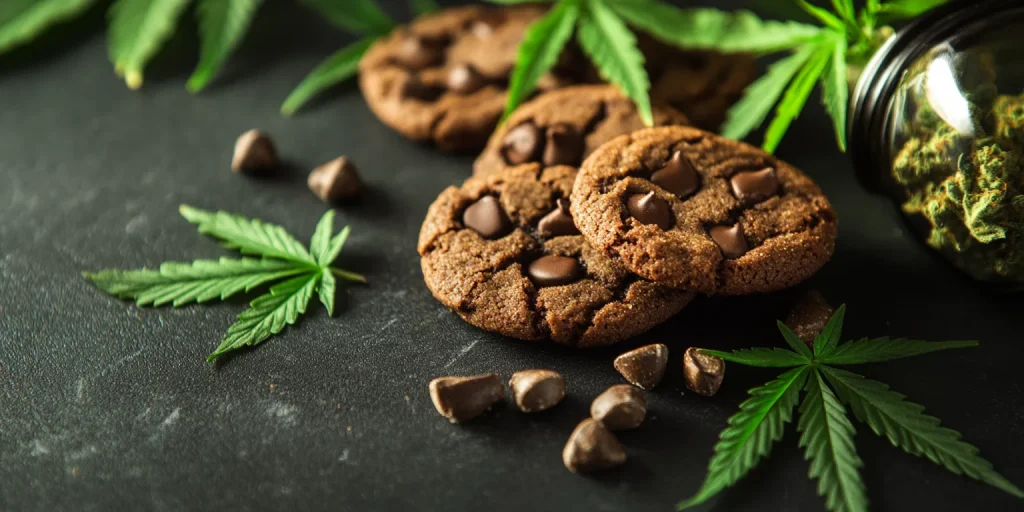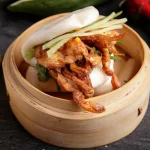
Weed Cookie Recipe : A Delicious Way to Enjoy Cannabis
Introduction
Yo, fellow stoners! If you’re here, you’re probably looking to whip up some dank weed cookies. Well, you’ve come to the right place. There’s nothing quite like biting into a warm, gooey cookie that’s not just sweet but also gives you that perfect buzz. Weed cookies are a tasty, discreet, and long-lasting way to enjoy cannabis, whether you’re chilling solo or sharing with friends.
What Are Weed Cookies?
Simply put, weed cookies are your classic cookies with a twist—they’re infused with cannabis! By mixing cannabis-infused butter or oil into your cookie dough, you turn a regular treat into a whole vibe. Weed cookies are one of the most popular edibles out there because they’re easy to make, dose, and enjoy. Plus, who doesn’t love cookies, right?
Why Are Weed Cookies a Popular Method of Consuming Cannabis?
Weed cookies are a favorite among cannabis enthusiasts for a bunch of reasons. First off, they’re super convenient. You can take them anywhere, and they don’t give off that tell-tale weed smell like smoking does. Plus, edibles like these offer a longer-lasting high that’s perfect for a chill night in. They’re also great for those who want to avoid smoking or vaping but still want to enjoy the effects of cannabis.

Ingredients for best Weed Cookie Recipe
Alright, before we dive into baking, let’s talk ingredients. To make weed cookies, you’ll need:
- Cannabis: The star of the show! You’ll need some good-quality bud. The amount depends on how strong you want your cookies, but a typical batch might use anywhere from 3.5 to 7 grams.
- Butter or Oil: This is what you’ll infuse with your cannabis. Most recipes use unsalted butter, but coconut oil works great too if you’re looking for a dairy-free option.
- Sugar: Regular granulated sugar and brown sugar will give your cookies that perfect sweetness and chewy texture.
- Flour: All-purpose flour is your go-to here.
- Eggs: To bind everything together.
- Baking Soda and Salt: Just a pinch for that classic cookie structure.
- Vanilla Extract: For a little extra flavor.
- Optional Mix-ins: Chocolate chips, nuts, or even some sea salt to sprinkle on top.
You can find most of these ingredients at your local grocery store, and for the cannabis, check out your nearest dispensary.
Recipe for Weed Cookies
Alright, let’s get baking! Here’s how you can make your own weed cookies at home:
Step 1: Decarboxylate the Cannabis
First things first, you gotta decarboxylate your cannabis. This process activates the THC, turning it from THCA into the stuff that actually gets you high. Just break up your buds, spread them out on a baking sheet, and pop them in the oven at 240°F (115°C) for about 30-40 minutes. Give them a gentle shake halfway through to make sure they heat evenly.
Step 2: Infuse the Cannabis into Butter or Oil
Next up, it’s time to infuse your butter or oil. Melt your butter (or oil) in a saucepan on low heat, then add your decarboxylated cannabis. Let it simmer on low for 2-3 hours, stirring occasionally. Be careful not to let it boil—low and slow is the way to go. Once done, strain the mixture through a cheesecloth to remove the plant material, and you’ve got your cannabis-infused butter or oil ready to go!
Step 3: Mix the Infused Butter or Oil into the Cookie Dough
Now, the fun part! Mix your infused butter or oil with the sugars, then add in the eggs and vanilla extract. Slowly mix in the flour, baking soda, and salt until you’ve got a nice dough. Fold in any extra goodies like chocolate chips or nuts, and you’re ready to bake.
Baking and Enjoying Weed Cookies

How Long Do You Bake Weed Cookies For?
Preheat your oven to 350°F (175°C). Scoop out balls of dough onto a baking sheet and bake for 10-12 minutes, or until the edges are golden brown. Keep an eye on them—you don’t want to overbake and lose that soft, chewy center!
How Should You Store Leftover Weed Cookies?
If you don’t end up devouring them all in one sitting, store your leftover weed cookies in an airtight container. They’ll stay fresh for about a week at room temperature, or you can freeze them for longer storage. Just remember to label them—wouldn’t want anyone accidentally munching on your special treats!
And there you have it, folks! A simple, delicious way to enjoy your cannabis. Weed Cookie Recipe are perfect for sharing with friends or just treating yourself after a long day. Just remember to start with a small dose and wait at least an hour before reaching for that second cookie—edibles can sneak up on you! Enjoy your baking, and stay lifted!
If you have any questions contact me 🙂
Best Weed Cookie Recipe
Frequently Asked Questions (FAQ) for Weed Cookie Recipe
1. What type of cannabis should I use for making weed cookies?
When making weed cookies, you can use either cannabis flower or cannabis-infused oil/butter. Here’s a breakdown of your options:
- Cannabis Flower:
- Decarboxylation Required: If you choose to use cannabis flower, it’s crucial to decarboxylate it first. This process activates the THC and CBD, the compounds responsible for the psychoactive effects. To decarboxylate, grind the cannabis and spread it evenly on a baking sheet. Bake it at 220-240°F (104-115°C) for 30-40 minutes, stirring occasionally to ensure even heating. This step is essential for ensuring the cannabis is effective when added to your recipe.
- Infusion Needed: Once decarboxylated, you can infuse the cannabis into butter or oil. The infused butter or oil is then used in the cookie dough.
- Cannabutter:
- Convenient and Effective: Cannabutter is a popular choice because it’s easy to incorporate into cookie recipes. You make it by melting butter and infusing it with decarboxylated cannabis. The result is a butter that carries the potency of cannabis, which you then use in place of regular butter in your cookie recipe.
- Cannabis-Infused Coconut Oil:
- Versatile Option: Cannabis-infused coconut oil is another excellent choice. It provides a subtle coconut flavor and can be used in various recipes. The process of making cannabis-infused coconut oil is similar to making cannabutter: heat the oil with decarboxylated cannabis and strain out the plant material.
Choosing the Right Option:
- For Ease of Use: Cannabutter and cannabis-infused oil are straightforward and integrate seamlessly into cookie recipes, making them preferred choices for many bakers.
- For Direct Use: If you prefer to use cannabis flower directly, you’ll need to prepare it by decarboxylating and then infusing it into a fat like butter or oil, which adds an extra step to the process but allows for more control over potency.
In summary, while you can use either cannabis flower or pre-made cannabis-infused oils/butters, using pre-made cannabis butter or oil simplifies the process and is a common practice among bakers.
2. How do I decarboxylate cannabis?
Decarboxylation is a crucial process that activates the cannabinoids in cannabis, such as THC and CBD, making them effective for edibles. Here’s a step-by-step guide to ensure you get the best results:
- Preheat Your Oven:
- Set your oven to 220-240°F (104-115°C). This low temperature is ideal for activating the cannabinoids without degrading them.
- Prepare the Cannabis:
- Grind the cannabis lightly to increase its surface area. You don’t need a fine powder; a coarse to medium grind works well. This helps ensure even heating and activation.
- Spread on a Baking Sheet:
- Line a baking sheet with parchment paper or aluminum foil to prevent sticking and ensure easy cleanup. Spread the ground cannabis evenly across the sheet to allow for uniform heating.
- Bake:
- Place the baking sheet in the preheated oven. Bake the cannabis for 30-40 minutes, stirring every 10 minutes to promote even heating. The cannabis is ready when it turns a light brown color and releases a fragrant, slightly nutty aroma.
- Cool:
- Once baked, remove the cannabis from the oven and let it cool completely. Cooling helps to stop the decarboxylation process and makes it easier to handle.
- Store or Use:
- After cooling, the decarboxylated cannabis can be used immediately in your recipe or stored in an airtight container in a cool, dark place for future use.
Tips:
- Avoid High Temperatures: Baking at temperatures above 240°F (115°C) can degrade cannabinoids and affect the potency of your final product.
- Odor Control: The process will produce a strong cannabis smell, so ensure you have proper ventilation or consider using an oven with good air filtration.
By following these steps, you’ll ensure that your cannabis is properly activated, providing the full benefits and potency needed for your weed cookies.
3. How much cannabis should I use in the cookie recipe?
The amount of cannabis to use in your cookie recipe depends on several factors, including the potency of your cannabis infusion and your desired dosage. Here’s a general guideline to help you determine the right amount:
- Cannabis Infusion Strength:
- Cannabutter or Oil: For a moderate potency, typically 1 cup of cannabutter or cannabis-infused oil is made with 7-10 grams of decarboxylated cannabis. This amount can vary based on the strength of the cannabis and how it was processed. Always check the potency of your infusion to gauge how much to use.
- Dosage Calculation: If you’re using store-bought cannabis butter or oil, refer to the product’s potency information to adjust your recipe accordingly.
- Starting Point:
- Begin Conservatively: If you’re new to making edibles or unsure about the potency, start with a smaller amount of cannabis. For instance, using 5-7 grams of cannabis per cup of butter or oil can yield a milder effect, which is easier to gauge.
- Adjusting Potency:
- Sample and Adjust: After baking, if you find the cookies are too strong or too mild, adjust the amount of cannabis in future batches. It’s easier to increase the amount in subsequent recipes than to correct a batch that’s too potent.
- Portion Control: Consider making cookies of uniform size to help manage dosage. For instance, if you’re aiming for each cookie to have a specific amount of cannabis, divide your dough into evenly sized portions.
- Calculate Dosage per Cookie:
- Estimate Dosage: To estimate the potency per cookie, divide the total amount of cannabis in your batch by the number of cookies you make. For example, if you use 10 grams of cannabis to make 24 cookies, each cookie will contain roughly 0.42 grams of cannabis. This is a simplified calculation; for more accurate dosing, consider testing your infusion’s potency.
- Consider Personal Tolerance:
- Individual Variability: Keep in mind that individual tolerance to THC can vary. What is a moderate dose for one person might be too strong for another. Always start with a small piece and wait at least an hour before consuming more.
By starting with a moderate amount and adjusting as needed, you can better control the potency of your cookies and ensure a pleasant experience for yourself and your guests.
4. How do I make cannabutter or cannabis-infused oil?
To make cannabutter, melt butter in a saucepan over low heat, then add finely ground decarboxylated cannabis. Simmer on low for 2-3 hours, stirring occasionally. Strain the mixture through cheesecloth or a fine mesh strainer into a container and refrigerate. For cannabis-infused oil, follow the same method using coconut oil or another oil of your choice.
5. How can I ensure my weed cookies are evenly dosed?
To ensure even dosing, mix the cannabutter or cannabis oil thoroughly into the cookie dough. Divide the dough into uniform portions, and bake them on a parchment-lined baking sheet. Using a cookie scoop or measuring spoon can help keep the size consistent.
6. Can I use cannabis tincture instead of cannabutter?
Yes, you can use cannabis tincture as an alternative, but you’ll need to adjust the recipe since tinctures are more potent and liquid. Start with a small amount and mix it into the cookie dough, adjusting as needed based on the tincture’s potency and your desired strength.
7. How can I control the potency of my cookies?
To control potency, calculate the amount of THC/CBD in your cannabutter or oil and divide it by the number of cookies you plan to make. This will give you an approximate dosage per cookie. Keep in mind that individual tolerance levels vary, so start with a small piece and wait at least an hour before consuming more.
9. Can I substitute ingredients in the cookie recipe?
Yes, you can substitute ingredients based on dietary needs or preferences. For instance, you can use gluten-free flour if you have gluten sensitivities or dairy-free alternatives like coconut oil instead of butter. Just ensure that your substitutions work well with the recipe’s overall balance.
10. How can I make my weed cookies taste better?
Enhancing the flavor of your weed cookies can make them more enjoyable and mask any strong cannabis taste. Here are some tips and ingredients to consider:
- Add Flavorful Mix-ins:
- Chocolate Chips: Adding chocolate chips can not only enhance the taste but also help balance the earthy flavor of the cannabis. Dark, milk, or white chocolate chips can all work well, depending on your preference.
- Nuts: Chopped nuts like walnuts, pecans, or almonds add a delightful crunch and rich flavor. Toasting the nuts slightly before adding them can also bring out their natural oils and enhance their taste.
- Dried Fruit: Incorporate dried fruits such as cranberries, raisins, or apricots for added sweetness and a chewy texture that complements the cookie base.
- Incorporate Spices and Extracts:
- Vanilla Extract: A splash of vanilla extract can enhance the overall flavor profile of your cookies and help mask any strong cannabis taste. Aim for pure vanilla extract for the best results.
- Cinnamon: Adding a teaspoon of ground cinnamon or other spices like nutmeg or cloves can provide a warm, comforting flavor that pairs well with the sweetness of cookies.
- Cocoa Powder: For a richer chocolate flavor, you can mix in some cocoa powder. This adds depth to the cookies and can complement the flavor of chocolate chips if you’re using them.
- Adjust Sweetness:
- Sugar Variations: Experiment with different types of sugar, such as brown sugar, which adds a hint of molasses and richness, or honey and maple syrup for natural sweetness. Adjust the amount to suit your taste.
- Use Quality Ingredients:
- Butter: Use high-quality butter or alternative fats for a richer flavor. If you’re making cannabutter, ensure it’s well-strained and smooth for the best taste.
- Flour: Opt for fresh, high-quality flour. If you’re using whole grain or specialty flours, be aware that they can affect the texture and flavor of your cookies.
- Experiment with Texture:
- Crunch vs. Soft: Depending on your preference, you can experiment with different baking times to achieve a crispy or chewy texture. Adding oats or different types of flour can also alter the texture and flavor of the cookies.
- Incorporate Flavor Enhancers:
- Zest and Extracts: Adding citrus zest, like lemon or orange, or a splash of almond extract can introduce bright, complementary flavors that enhance the overall cookie experience.
- Test and Adjust:
- Taste Testing: Before baking a full batch, consider making a small test batch to adjust flavors and textures as needed. This allows you to perfect your recipe without wasting ingredients.
By integrating these flavorful additions and adjustments, you can create weed cookies that not only effectively mask the cannabis flavor but also provide a delicious and enjoyable treat.
11. How long do weed cookies take to kick in?
The effects of weed cookies can vary significantly based on several factors. Here’s a detailed overview of what to expect:
- Time Frame:
- General Range: The effects of weed cookies typically begin to be felt between 30 minutes to 2 hours after consumption. This delay is because the cannabinoids must be processed through your digestive system and metabolized by your liver before entering your bloodstream.
- Factors Affecting Onset:
- Metabolism: Your individual metabolism plays a key role. People with faster metabolisms may feel the effects sooner than those with slower metabolisms.
- Tolerance: Your previous exposure to cannabis and your personal tolerance level will influence how quickly you feel the effects. Regular users might experience a quicker onset compared to occasional users.
- Potency: The strength of your cookies, determined by the amount of cannabis used in your recipe and the potency of your infusion, will affect how soon and how intensely you feel the effects.
- Dosage and Consumption:
- Start Small: It’s crucial to start with a small portion, especially if you’re new to edibles or unsure of the potency. Consuming a small piece (like half a cookie or a small bite) will help you gauge the effects without risking overconsumption.
- Wait Patiently: After consuming, wait at least 1-2 hours before eating more. This waiting period allows you to accurately assess the effects before potentially taking more. Edibles can have a delayed onset, and consuming too much too quickly can lead to uncomfortable experiences.
- Effects and Duration:
- Onset: Initially, you may experience subtle effects such as relaxation or mild euphoria. As the high develops, you may feel more pronounced effects like increased appetite, altered perception, or a heightened sense of relaxation.
- Duration: Once the effects kick in, they can last anywhere from 4 to 8 hours or even longer, depending on the dosage and your individual response. The peak effects are usually felt within the first few hours.
- Additional Considerations:
- Hydration and Food: Eating a substantial meal before consuming edibles can help moderate the absorption rate and make the effects more predictable.
- Environment: Consuming edibles in a comfortable, safe environment can enhance the overall experience and help you manage any potential side effects more effectively.
By understanding these factors and proceeding cautiously, you can better manage the effects of your weed cookies and ensure a more enjoyable experience.
12. Can I make vegan weed cookies?
Yes, you can make vegan weed cookies by using plant-based alternatives such as vegan butter or coconut oil. Substitute eggs with flax or chia seed eggs (1 tablespoon of flaxseed or chia seeds mixed with 3 tablespoons of water per egg) to maintain the cookie’s texture.
13. What should I do if my cookies come out too strong?
If your cookies are too strong, try reducing the amount of cannabis in future batches or increase the number of cookies to distribute the THC/CBD more evenly. If you’ve already baked a batch, you can cut them into smaller pieces to help manage dosage.
14. Are there any special considerations for making weed cookies for others?
Always clearly label cannabis-infused cookies to ensure others are aware of their contents. Be mindful of local laws and regulations regarding the distribution of cannabis edibles, and consume responsibly.
By addressing these common questions, you can ensure a smoother baking process and a more enjoyable experience with your weed cookies.



